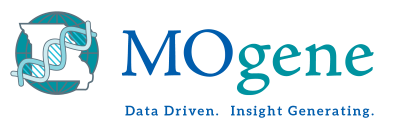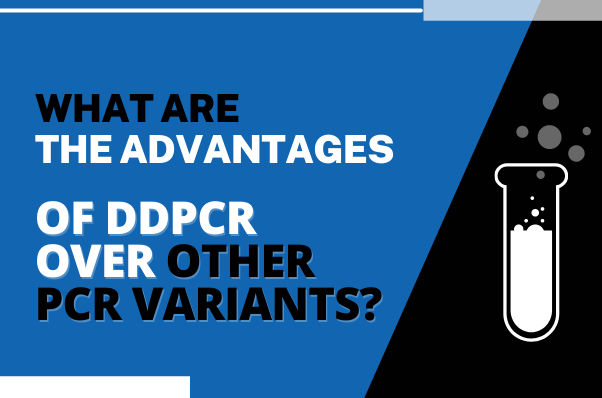Digital droplet polymerase chain reaction (ddPCR) is a relatively new form of PCR with a wide range of applications in clinical, animal, plant, and environmental studies. ddPCR is a variant of digital PCR based on a water-oil emulsion system. Its main principle is massive partitioning of the target sample – dividing the template nucleic acid into twenty thousand nanoliter-sized droplets.
Each of these sample droplets contains one or more target sequences. Instead of performing one PCR analysis on a single sample, every droplet becomes a PCR sample of its own. At the end of the amplification process, the droplets are assessed to see which contain the target sequence (positive droplets) and which do not (negative droplets). Using a Poisson distribution, the fraction of positive droplets helps determine the concentration of the template in the original sample.
Doubtlessly, ddPCR has a whole host of advantages over other PCR variants.
ddPCR vs. qPCR
Real-time PCR (qPCR) is a relatively quantitative analysis method. It is possible to calculate the initial concentration of target samples via qPCR, but only through the use of a standard curve and extrapolation. It doesn’t provide absolute quantification and is thus considered an “analog” measurement.
For qPCR, the intensity of fluorescence at specific times in the amplification process is important. These levels of fluorescence are typically measured at the end of every amplification cycle. The value derived from these measurements is called threshold per cycle (CT), and it serves to calculate the amount of the initial DNA concentration.
In contrast, no extrapolation, standard curves, or references are required for ddPCR. The foundation of this method is absolute quantification obtained at the end of the amplification when the experiment is completed. Therefore, ddPCR is considered a “digital” measurement. Because each sample’s fluorescence is measured after everything is finished, ddPCR isn’t as sensitive to varying amplification efficiencies, the presence of PCR inhibitors, or primer-template mismatch as qPCR.
Furthermore, qPCR isn’t as precise as ddPCR. It can distinguish between copy number variations or differences in gene expression that are twofold or smaller. In contrast, ddPCR detects differences in gene expression of less than 30%, identifies alleles that are less frequent than 0.1%, and distinguishes between copy number variations that are different by only one copy.
ddPCR vs. Other dPCR Technologies
Digital polymerase chain reaction technologies (dPCR) have a range of benefits compared to conventional PCR methods. Nevertheless, they have a few disadvantages as well. Namely, standard dPCR techniques lack practicality and aren’t scalable. Samples are diluted serially and manually, which can lead to pipetting errors. If partitioning is performed via a chip-based system, it is time-consuming and complex to manage the fluidics schemes required for it.
ddPCR does not come with the same issues. The partitioning process is done via a droplet generator that makes it incredibly easy to separate each sample well into twenty thousand droplets. If a good system is used, all the droplets are uniform in size and shape, meaning the results are robust and reproducible.
Another significant advantage of ddPCR over simple dPCR is that thanks to the sheer number of droplets formed for experimentation, it can generate tens of thousands of data points and not just a single result. The entire ddPCR workflow consists of only a handful of steps that are not difficult to master. With the right system, droplet formation, thermal cycling, droplet reading, and data analysis is accessible to any research laboratory.
Benefits of ddPCR
Even without directly comparing it to other PCR methods, ddPCR is unparalleled when it comes to replicating, amplifying, and accurately quantifying nucleic acids.
Here are some of the most significant benefits of ddPCR:
- Absolute quantification. Because ddPCR doesn’t require extrapolations or standard curves, it is ideal for microbial quantification, viral load testing, and target DNA measurements. It provides an absolute count of target nucleic acid copies per sample volume, most commonly copies per µl.
- Superior accuracy and partitioning. Chip-based dPCR systems divide samples only into hundreds or possibly thousands of partitions. However, ddPCR can produce around twenty thousand droplets per sample of 20 µl. More droplets represent more data points and more accurate results at the end of the amplification.
- Simple quantification. As described above, the quantification in ddPCR is incredibly straightforward. All you need is a droplet reader that detects positive droplets (those that contain target DNA copies) and negative droplets (those that contain no target DNA copies). The fraction of positive droplets is fitted to Poisson statistics to find the target concentration of the original sample.
- Unparalleled precision. This type of precision is a huge advantage over qPCR. ddPCR can precisely measure small fold differences in target sequence copies between samples, which is especially useful in genetic testing.
- Eliminated PCR bias. Error rates in ddPCR are dramatically reduced, no matter their origin. Some may still occur, but the chances are insignificant compared to qPCR and traditional PCR methods.
- Improved signal-to-noise ratio. ddPCR sensitivity is useful in detecting rare targets, those that have a low frequency in a wild-type background. ddPCR has a precision of ±10% because of high target nucleic acid concentration in positive droplets. The wild-type sequences and high-copy templates are diluted.
- Cost-effectiveness. Reaction volumes in ddPCR are in the range of nano- and picoliters. The quantity of samples and reagents required for experiments is minimal, further lowering the costs.
ddPCR can also be performed on any standard thermal cycler. No chip-based systems or microfluidic technology is required since ddPCR is emulsion-based.
Should you go for qPCR or ddPCR?
It would be simple to declare that one PCR method is good and the other one is bad and call it a day. But science is not that black and white. Whether you should opt for qPCR or ddPCR for your project depends on several factors, such as the type of the sample material, the presence of PCR inhibitors, economic factors, how fast you need the results, and similar.
Real-time PCR (qPCR) is a good choice for the following applications:
- Gene expression
- Pathogen detection in infectious diseases
- Environmental studies
- Detection of siRNA, lncRNA, and miRNA
Droplet digital PCR (ddPCR) is better for these applications:
- Genome edit detection
- SNP/Mutation detection
- Next-generation sequencing
- Standards validation
- Copy number validation
qPCR provides a wider dynamic range if you need to screen a large number of samples. It also has a high throughput. On the other hand, ddPCR is infinitely more precise and great for fractional abundance (finding the mutant/wild-type ratio). Neither technology is good or bad – they’re simply built for different experiments. Thanks to both qPCR and ddPCR, researchers have a wide range of solutions at their fingertips for various genomic applications.
Conclusion
Sequencing, cloning, and quantification of target nucleic acid sequences have never been as easy as with ddPCR. It is undoubtedly one of the most precise, accurate, and robust methods for DNA, cDNA, and RNA amplification out there.
Compared to qPCR, ddPCR provides absolute quantitation, does not require any special PCR systems or calculations, is less sensitive to PCR inhibitors, and changes in amplification efficiencies. It also delivers highly accurate results at the end of the process.
ddPCR shows advantages even over standard dPCR methods. Its partitioning method is easier and more scalable.
However, it would be wrong to assume that ddPCR is the magical solution for every single one of your following projects. Sometimes, real-time PCR or standard digital PCR is also a good option, depending on the type of the project.
If you want to know more about the differences between PCR methods and which one would work best for your goals, please contact MOgene for more information. We’d be glad to help you with our services.

